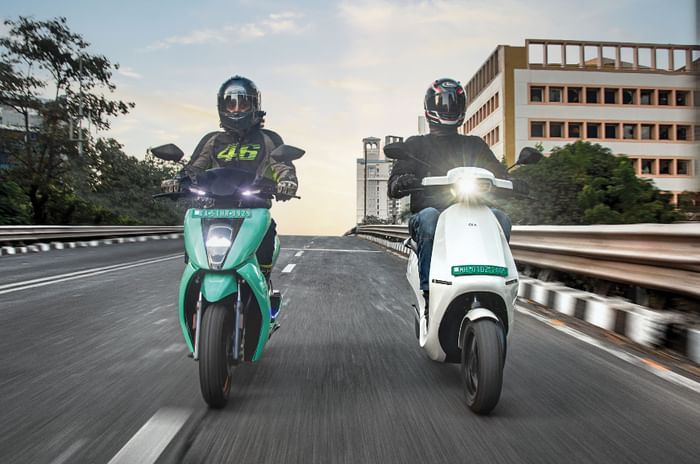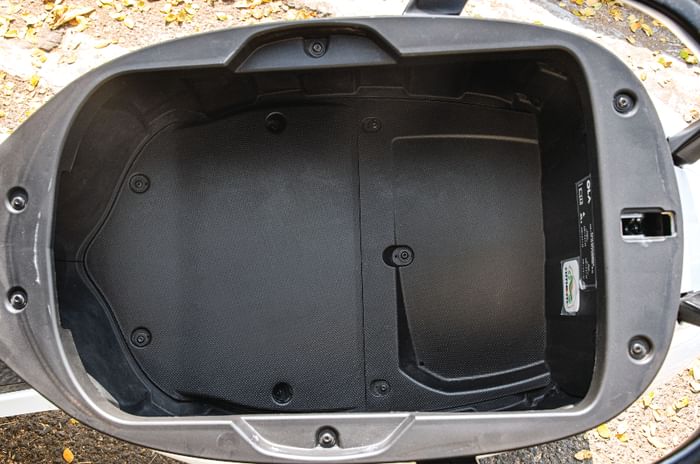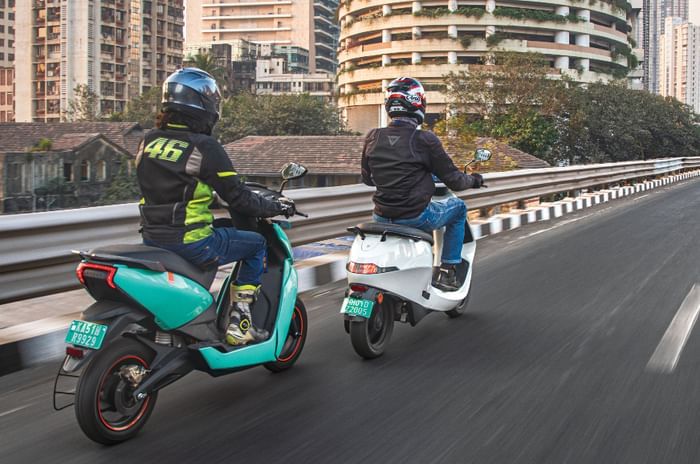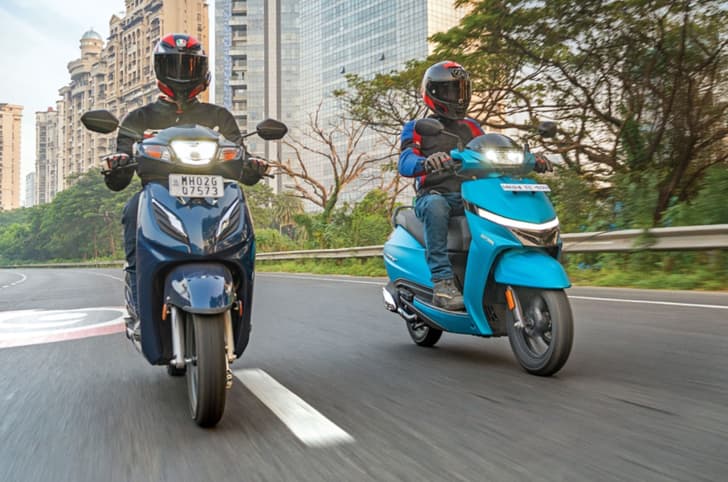For a good few years now, the Ather electric scooter has been the best EV on sale in India, even if its availability was restricted for what seemed like ages. But there’s finally a legitimate new rival to that claim in the form of the Ola S1 Pro. On paper, the Ola outdoes the Ather in every factor that matters, and we’ve finally got the chance to see how that pans out in the real world.
EYES ON THE PRIZE
The first impression is that these are both stylish and modern looking machines. The Ather’s floating side panels and its unique rear LED lights still stand out today, even though the scooter is starting to become a familiar sight. The Ola in comparison looks larger and I find that its swooping curves, single sided front suspension, android-like headlamps and fatter tyres help it look even more futuristic.
Ola has also made it appear like the scooter has a much bigger infotainment display, but this is just a clever illusion made by using extremely large bezels. In fact, both scooters use a 7-inch TFT display, which is still pretty incredible for this segment and price point.
Style is always subjective, but there’s no escaping that the Ather’s level of quality and finish is on another level. Everything on the 450X, from the mirrors to the number plate holder and even the side stand, feel extremely high quality. The S1 Pro, on the other hand, doesn’t impress when you take a closer look, with inconsistent panel gaps and a general lower level of fit and finish.

As for features, these are probably the highest-specced made-in-India two wheelers. The Ather has been the king in this regard all this while with its rich TFT display, a reverse feature, Bluetooth connectivity, navigation, connected data and over-the-air updates. But when Ola made its grand debut last August, it made waves with the promise of even more features.
Some of these are quite mould-braking, like the fact that the scooter doesn’t have a physical key and that it can be started either by using your smartphone as a digital proximity key or by entering a six digit pin on the TFT display. In theory, this sounds quite futuristic, but in practice, it’s a tedious, time consuming affair where you have to press a button, enter the pin, and then hold the brake and press another button before being able to ride. It doesn’t help that Ola’s screen is occasionally glitchy and slow to respond, and we definitely missed the simplicity and security of a physical key.
Using a paired phone might be more seamless, but there’s no way to be sure because that particular feature, along with many others, is not yet available on the Ola S1 Pro. In fact, the Bluetooth connectivity, navigation, music playback, cruise control or the different display moods are all promised in future software updates.
THE SILENT MOVERS
The next area where the Ola has a massive advantage is in the motor specifications, not just in peak power (8.5kW vs 6kW), but also in terms of outright performance. Both scooters produce an audible whine and some occasional mild vibrations under acceleration, but the Ola’s motor is noticeably quieter and smoother in general.

However, it seems that Ola has made some changes to the scooter since we last rode it (and reported that there were performance-related thermal issues), because each of the four riding modes now seems dumbed down in the initial acceleration. When you first open the accelerator, the response is very dull and it’s only once the scooter crosses about 25-30kph that the performance you would expect starts to arrive. Our performance tests reflect this as well, and mode for mode, the Ather 450X is quicker than the Ola upto 40kph.
Once you cross 50kph, the Ola leaves the Ather behind, but that low end zip that makes EVs so exciting is missing unless you put it in the fastest Hyper mode. Something else we noticed is that the Ola also has a significant amount of speedo error. Ola claims a top speed of 115, but at an indicated top speed of 115kph the actual true speed according to our Vbox is 99.8kph. The Ather also has speedo error, but it’s Vbox-rated 80.3kph is exactly what the company claims.
Despite Ola having toned down the performance in each mode, we still got a couple of high temperature warnings for the motor, once during our performance tests and once when riding in a hilly area. In this time, the scooter shifted itself from Hyper mode to a restricted version of Normal mode. Once it cooled down for about fifteen minutes, things went back to normal.
Another irritant with the Ola in heavy traffic is that the accelerator gets disconnected even if you lightly apply either of the brakes.
A MATTER OF CONVENIENCE
The Ather doesn’t do this, but it feels more compact, and tall riders must remember to get their knees out of the way while making tight turns. While it is physically smaller, the Ather is also considerably lighter thanks to its smaller battery and fancy aluminium chassis. With its skinny tyres, the Ather’s handling feels sharper and the same goes for its brakes. Both have combined braking systems with disc brakes at both ends, although the Ather can still lock up its rear wheel quite easily.

The Ola, in comparison, is much more spacious, it has a more comfortable seat and taller riders will definitely prefer it. As for that centre tunnel on the Ola’s floorboard, I never really noticed it and it will only be an issue if you plan to carry large and heavy items. The S1 also has a huge underseat storage space, and even though the Ather’s boot is quite good, the Ola’s is much better.
The story is similar when it comes to the suspension set-up. The Ather’s set-up is quite firm in comparison and the Ola is definitely more absorptive, especially at the rear. As for that unique front suspension, it handles rounded out bumps well, but if you hit something sharp it does react with a bit of a thud.
GOING THE DISTANCE
Now, onto the big one – how far can each of these go on a fully charged battery? Once again, the Ola S1 Pro completely trumps the Ather 450X with a battery that is 50 percent larger, and the result absolutely shows in the real world.
We tested both scooters in two modes, running them all the way from 100 percent till the batteries were fully depleted and the scooters had to be pushed to a charger. We rode through a variety of situations, including through heavy jams and on wide roads with fast moving traffic. The simple rule was to ride naturally and flow with the traffic.

With both scooters in Sport mode, we got a respectable 74km from the Ather, but the Ola really impressed with being able to cover just over 100km. In our second test, we kept the Ather in Ride mode and the Ola in Normal mode and the numbers were even better. This time, the Ather covered 88km and the Ola managed a fantastic 127km.
These figures are very real-world usable and are particularly impressive on Ola’s part. However, we learned the hard way not to trust it’s range indicator, because on both runs, the battery suddenly went dead when the display told us that there was still 10km of range left. In comparison, the Ather’s range indicator was amazingly accurate and completely trustworthy.
Charging the flat batteries with the provided portable chargers took about four-and-a-half hours on the Ather, while the Ola’s bigger battery needed over seven hours. Neither of these scooters have removable batteries, but both companies are investing in a fast charging network across the country.
A TWIST IN THE TALE
So, to sum things up, Ather has offered a fantastic scooter all these years, but with this new competition, it needs to up its game, especially given its premium pricing. The Ola has stronger outright performance, it has better range, it’s more comfortable and it works out to be significantly more affordable than the Ather when you factor in the state and national level subsidies. In Maharashtra, for example, the Ola S1 Pro costs Rs 1.11 lakh on road, while the Ather is priced at Rs 1.35 lakh on road.
While it sounds like the Ola has a clear win, there are a few points to consider. For starters, Ola’s home delivery model and service still has a lot to prove. Even at the relatively low numbers being dispatched at the moment, Ola’s social media is full of customer complaints regarding delays, issues with registration, or a general lack of communication.
Then there are complaints with quality and the buggy software, but you could forgive this considering that this is the first product from a brand new company and Ola is working towards addressing its customer’s complaints. Another, more relevant worry is the fact that the scooter is still having performance-related thermal issues. But again, hopefully, this is something they will eventually be able to sort out.
However, in recent weeks, a few customers have started sharing instances of a much more serious fault, where the scooter unexpectedly goes into reverse even when the rider has selected a forward riding mode. This actually happened to us as well, where the scooter showed that it was in Normal mode, but it shoots backwards without any warning when you twist the accelerator open from a standstill.
That is a serious, dangerous and unacceptable flaw from any vehicle that’s available for the public to buy. It simply echoes concerns that we and many others have expressed that Ola has rushed this product to the market without sufficient validation testing.
At this point, therefore, we can’t recommend the Ola, even though it comes across as the more compelling product. Not until Ola clearly addresses these critical bugs and problems and it can reliably offer what was initially promised. Until then, the tried, tested and proven Ather remains the safer buy.










































